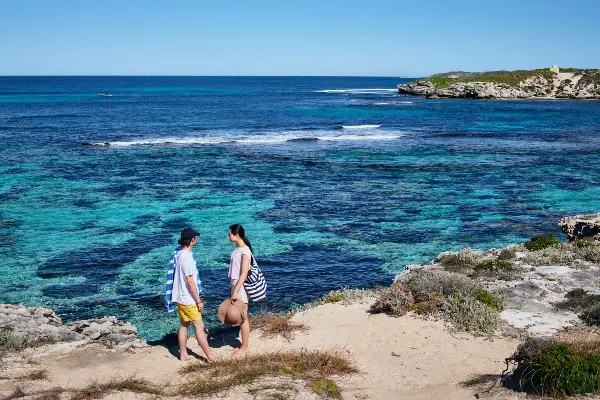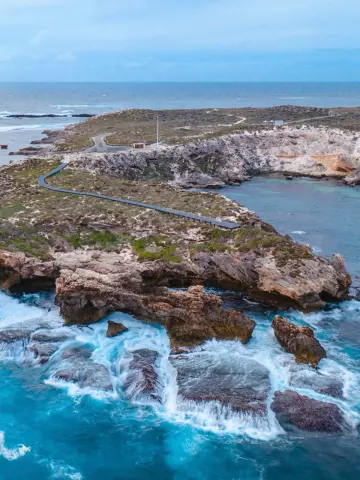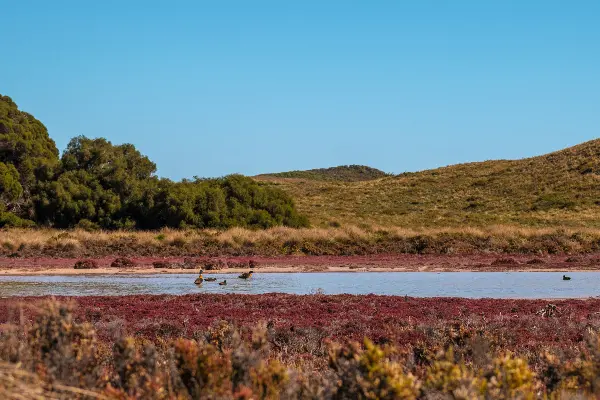

The season of spring sees a kaleidoscope of colours appear across Wadjemup / Rottnest Island. Warmer weather brings bursts of wildflowers, copious wildlife and a renewed landscape to explore and appreciate.
Rottnest Island in spring
Spring encompasses the months of September, October and November in Australia. September also marks the final month of the Noongar season, Djilba, when the rains start to ease, and quokka joeys start to peek their heads from their mother's pouch. This season is also marked by an abundance of seeds, berries, honey and fish as well as other mammals and birds. October sees the emergence of the Noongar season of Kambarang, which continues until November. This time is a visual feast, welcoming wildflower season as the native Wadjemup Daisy and maro (Wadjemup tea tree) burst into bloom over the island. With warmer days returning, signs of new life and summer crowds yet to appear, this is a stunning time to visit Wadjemup.
Weather to expect during spring on Rottnest Island
The season of spring sees temperatures that are slightly cooler than the mainland of Perth, averaging around 18-23°C daily. As the spring months progress, the cool air clears away quicker in the mornings and evenings, giving way to pleasant days. This makes water-based activities such as swimming, snorkelling and relaxing on the sand popular amongst travellers. It’s also a great time to explore after winter rains have refreshed the island, leaving salt lakes and wetlands full and teeming with native flora and fauna.
What you can do during spring
Looking for inspiration? Here are the natural surrounds, wildlife sightings and historical experiences that are best appreciated during spring.
Frequently Asked Questions
The return of warmer weather and the rejuvenated natural environment create an inviting experience that can be enjoyed on the hiking or cycling trails, or in the waters that surround the island. Better still, the few businesses that close during the winter season begin to reopen for summer, offering many places to dine and drink and new ways to explore during your visit.
It’s advised that you pre-book your travel to the island, including meals and activities where possible, as school holidays fall during the spring period.
Wadjemup is slightly cooler than Perth during the spring months, however daytime average temperatures hover around 18-23°C. Due to Australia’s proximity to the equator, the sun provides a lot of warmth, so even lower forecasted temperatures can feel a lot warmer when the sun is out.
Swimming can be enjoyed all year round on Rottnest Island. As the weather warms up during spring, the waters become more inviting and can be entered with or without a wetsuit. Take the opportunity to beat the summer travellers and enjoy the serenity of the striking bays and beaches that surround the island.
Here are some recommended travel items to make your island experience as comfortable as possible.
- Enclosed shoes / hiking boots
- Sunscreen
- Hat
- Sunglasses
- Camera
- Water bottle (there are water refill stations around the island)
- Reusable coffee cup
- Light jumper or jacket
- Bathers (wetsuit if diving)
- Towel
The average temperature over the spring months on Rottnest Island are as follows:
- September: 13 – 18.9°C
- October: 14.1 – 20.6°C
- November: 15.9 – 23.1°C
As the island awakens from winter, the mild and pleasant temperatures make it perfect for outdoor adventures. Wander through blooming wildflowers, enjoy the gentle sea breeze, and soak in the sunshine.
Spring on Rottnest Island brings a gentle touch of rain, with average monthly rainfall as follows:
- September: 52.1 mm
- October: 27.3 mm
- November: 19 mm
Enjoy the balance of sunny days and occasional light showers, creating a perfect backdrop for your spring adventures along scenic trails to discover blooming wildflowers.
The Wadjemup Daisy, native to Wadjemup / Rottnest Island, begins to bloom from late October, especially along the coastal areas around Parker Point. The ideal time to witness these daisies in full bloom is during late spring.












_low-res-195.tmb-fallback.webp?Culture=en&sfvrsn=71158691_1)



